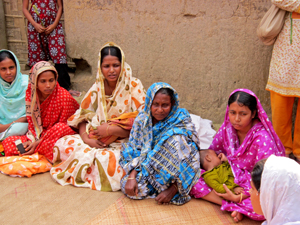This year, World Population Day will highlight the challenges facing adolescent girls, especially in the developing world.
Last year, the world's population reached seven billion. Around 16 million were girls under 18 who had given birth.
Pregnancy during adolescence has serious health impacts for girls and their babies–complications from pregnancy and childbirth are the leading causes of death among 15–19 year old girls in many developing countries.
The vast majority–around 90 per cent–of pregnant adolescents in the developing world are married. But for far too many, pregnancy has little to do with informed choice. Often it is a consequence of discrimination, rights violations (including child marriage), inadequate education or sexual coercion.
In many developing countries, adolescent girls lack access to quality health care. They are prevented by cultural norms and lack of education from making decisions about the timing, number and spacing of their children or whether they deliver their babies in hospital.
Some nations have made progress towards achieving Millennium Development Goal Five (reduce maternal mortality), but adolescent girls remain difficult to reach. Many are not in school. Many do not, or cannot, access health services on a regular basis.
Why should Australia help?
Australians understand the importance of quality education, family planning education and services, prevention of gender-based violence and access to health services.
Adolescent girls in the Asia-Pacific region need our help and attention. They are many of the 140 million women aged 15–49 who do not have access to modern methods of family planning.
Most concerning of all, this need actually increased in the Pacific between 2008 and 2012.
The Pacific has some of the highest rates of teenage pregnancy in the world. Studies have associated high rates of early, frequent and unprotected sexual activity among adolescents in the Pacific with early, unplanned and unwanted pregnancies. In some countries in the region, nearly one in every five babies is born to an adolescent girl. This threatens the health and wellbeing of both mothers and children.
How are we helping?
AusAID has decades of experience improving the lives of women and girls. We do it in a number of ways.
First, Australian aid helps educate girls and adolescents and gives them opportunities to prosper.
We have committed to helping four million children go to school by 2016, recognising that an educated woman is likely to have fewer and healthier children. Our 10-year Pacific Women Shaping Pacific Development initiative will improve opportunities for political, economic and social advancement of Pacific women, and tackle the underlying causes of violence against them.
Second, we are providing access to family planning services and education.
AusAID works with partners like the International Planned Parenthood Federation (IPPF) and Marie Stopes International to provide sexual and reproductive health services, including education, for young people and their partners. Australia has already committed to doubling expenditure on family planning to more than $53 million a year between 2010 and 2016. In May 2013, AusAID announced funding for an additional 900,000 women and girls in the Asia-Pacific to access maternal and child health services, including family planning, each year.
Third, we are improving health systems and promoting healthy lifestyles for adolescents.
Australia is helping to address shortages of health workers, and improving the proportion of women who give birth with a trained health worker present. In Nepal, the chances of women dying in childbirth have halved since 1996 and infant mortality rates have dropped thanks to government investment in health and education, supported by AusAID.
Fourth, we are supporting our partners, like the United Nations Population Fund (UNFPA), to mobilise resources.
This year marks 20 years since the adoption of International Conference on Population and Development (ICPD) Programme of Action. Australia, along with 179 other states, is participating in the ICPD Beyond 2014 review [external link] to influence the future of global population and development policy at national, regional and global levels.

